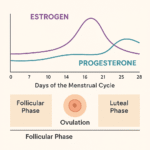Table of Contents
I. Introduction
The Power of Breastfeeding
Breastfeeding is a beautiful and natural process that offers numerous benefits for both mother and baby. Beyond providing essential nutrients and antibodies, breastfeeding can also play a role in family planning.
The Breastfeeding-Fertility Connection
One of the intriguing aspects of breastfeeding is its potential impact on fertility. Many women have wondered whether breastfeeding can act as a natural form of birth control. While breastfeeding can influence fertility, it’s important to understand the nuances of this relationship.

II. Can Breastfeeding Prevent Pregnancy?
The Lactational Amenorrhea Method (LAM)
The Lactational Amenorrhea Method (LAM) is a natural family planning method that relies on specific breastfeeding patterns to prevent pregnancy. For LAM to be effective, several conditions must be met:
- Exclusive Breastfeeding: The baby should be exclusively breastfed, meaning they receive only breast milk.
- Frequent Feeding: The baby should be breastfed frequently, day and night.
- No Menstrual Periods: The mother should not have resumed her menstrual cycle.
The Effectiveness of LAM
When practiced correctly, LAM can be highly effective in preventing pregnancy. However, it’s important to note that LAM is not foolproof. Factors like the baby’s age, feeding frequency, and the mother’s overall health can influence its effectiveness.
III. Breastfeeding and Fertility
Hormonal Changes During Breastfeeding
Breastfeeding triggers the release of hormones like prolactin and oxytocin, which suppress ovulation. Prolactin inhibits the release of follicle-stimulating hormone (FSH) and luteinizing hormone (LH), which are essential for ovulation.
The Impact on Ovulation and Fertility
As breastfeeding continues, the body’s hormonal balance shifts. As the baby grows and feeding patterns change, prolactin levels may decrease, leading to a return of ovulation and fertility. Factors like the baby’s age, feeding frequency, and the introduction of solid foods can influence the timing of this hormonal shift.
Natural Family Planning Methods and Breastfeeding
While LAM can be an effective method of birth control for some women, it’s essential to consider other natural family planning methods alongside breastfeeding. These methods, such as the symptothermal method or the cervical mucus method, can help women track their fertility signs and make informed decisions about family planning.
IV. Breastfeeding and Menstrual Cycle
Changes in the Menstrual Cycle
Breastfeeding can significantly impact the menstrual cycle. Many women experience amenorrhea, or the absence of menstrual periods, during the early months of breastfeeding. As breastfeeding continues, menstrual cycles may become irregular or delayed.
The Impact on Menstrual Cycle Regularity
The regularity of menstrual cycles can vary widely among breastfeeding women. Factors such as the baby’s age, feeding frequency, and the mother’s overall health can influence the timing and regularity of periods. As breastfeeding patterns change, menstrual cycles may gradually return to their pre-pregnancy pattern.
Menstrual Cycle Irregularities and Breastfeeding
Some women may experience irregular bleeding or spotting during the early months of breastfeeding. This is often due to hormonal fluctuations and can be normal. However, if you experience heavy bleeding, prolonged bleeding, or other unusual symptoms, it’s important to consult with a healthcare provider.
V. Conclusion
Breastfeeding offers numerous benefits for both mother and baby, including its potential role in natural family planning. While LAM can be an effective method of birth control when practiced correctly, it’s essential to be aware of its limitations and consider other natural family planning methods to ensure optimal reproductive health.
By understanding the relationship between breastfeeding and fertility, women can make informed decisions about family planning and embrace the joys of motherhood.
FAQs:
Can I rely solely on LAM for birth control?
While LAM can be effective, it’s important to be aware of its limitations. Factors like the baby’s age, feeding frequency, and the mother’s overall health can influence its effectiveness. Consider using additional birth control methods, especially if you’re not exclusively breastfeeding or if your menstrual cycle returns.
When can I start using other birth control methods after breastfeeding?
The best time to start using other birth control methods depends on your individual circumstances. Consult with your healthcare provider to determine the most appropriate method for you.
Can breastfeeding affect the quality of breast milk?
No, breastfeeding does not affect the quality of breast milk. Your body will continue to produce nutritious breast milk, even if you’re ovulating or menstruating.
You may like other relevant topics on pregnancy:
1.vitamins to avoid during pregnancy










